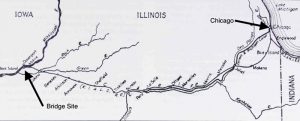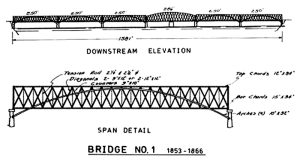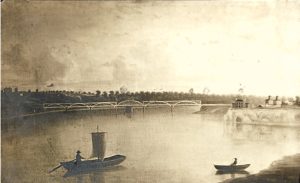19th Century Mississippi River Bridges Series
As early as 1842, some early promoters of the Transcontinental Railroad selected a route that would cross the Mississippi between Rock City, Illinois, and Davenport, Iowa. They chose this site based on a survey in 1837 by Lt. Robert E. Lee, as the river was narrow and separated by Rock Island, the home of a former army fort. This would require a bridge over each branch and an embankment across the island. In 1850, Congress passed an act granting public lands to railroad companies to encourage the country’s development. Congress also passed an act, in August 1852, granting a right-of-way for rail and plank roads on public lands.
A Railroad Bridge Company was formed by the Illinois Legislature on January 17, 1853, to “build, maintain, and use a railroad bridge over the Mississippi River, or that portion within the jurisdiction of the state of Illinois at or near Rock Island in such a manner as shall not materially obstruct or interfere with the free navigation of said river.” The Chicago & Rock Island railroad, originally the Chicago & LaSalle Railroad Company, chartered on February 27, 1847, was built connecting Chicago and Rock Island on the Mississippi River between 1852 and February 22, 1854, making it the first railroad to reach the river.
At the same time, the Mississippi & Missouri Railroad, chartered on January 1, 1853, by the State of Iowa, was being built between Davenport and Council Bluffs and would reach Muscatine, Iowa, in late 1855. The Federal Government granted it about 1.25 million acres of public land to assist in its construction. However, it would not reach Council Bluffs, the point President Lincoln picked as the east terminus of the Union Pacific Railroad on the Missouri River, until May 11, 1869. At the time, it had been purchased by the Chicago, Rock Island, and Pacific Railroad.

The question arose of what type of bridge should be built and who should design and build it so that it did not interfere with the “free navigation” of the river. The steamboat owners, of course, argued that any bridge would hinder navigation. A low-level bridge with three spans was chosen from the Illinois shore to the island, which was not the main shipping channel. This was followed by a curved track on an embankment and then turned over the main shipping channel at right angles to the flow. A low-level bridge with a swing span was deemed necessary to pass shipping.
At this time, the B & O Railroad was building its extension from Cumberland to the Ohio River and had adopted iron Fink Trusses for its bridge style. Other lines were using Whipple and Bollman iron trusses. Some lines, however, still used wooden trusses, typically Howe Trusses with wooden arches similar to those used by Theodore Burr, as they had a lower first cost.
An injunction was sought by the Secretary of War, Jefferson Davis, who wanted the transcontinental railroad in the south and the steamboat operators to stop construction, but it was denied. Construction began on July 13, 1853, with a cornerstone laying ceremony on September 1, 1854. On September 8, 1853, the Chicago & Rock Island Railroad purchased the charter of the Railroad Bridge Company.
The long single-track bridge over the shipping channel consisted of five 250-foot spans with two spans on the Illinois side and three spans on the Iowa side, flanking a 286-foot-span wooden swing bridge with a curved top chord. John Warner was selected to build the stone piers and abutments, and Stone, Boomer & Company of Davenport were selected to build the superstructure. Andros B. Stone (his brother, Amasa Stone, was the builder of the ill-fated iron Ashtabula Bridge) was the brother-in-law of William Howe, the patentee for wooden trusses with iron verticals. He had purchased the patent rights in the west and built many of this style of bridge.
The Swing (draw) span “rotated on a massive center pier with a top width of 32 feet and was supported by a turntable bearing arrangement with twenty wheels on a twenty-eight-foot diameter track” with approximately 150 feet of clearance on both sides when open. At the time, it was the longest swing span in the United States. Swing bridges had been built over some of the early canals, and Squire Whipple built two in Canada on the Great Western Railroad in the early 1850s, but this was, by far, the longest. Octave Chanute would build one a little longer in Peoria, Illinois, across the Illinois River about the same time. The Rock Island Bridge’s draw was operated for the first time on April 9, 1856, and the first scheduled train passed over on April 22, 1856.
At the grand opening, Mayor James A. Grant, Davenport, opined,
“All History proves the great path of the World’s Commerce to be from East to West; from India to Assyria and Egypt, from Egypt to Greece and Rome, from Rome to Spain and England, and from England to our own free America. It is certainly the duty of all wise men not to retard this Westward progress but rather to hasten it, bearing with it, as it does that blessed trinity, Commerce, Civilization, and Christianity; and that we regard all opposition to the workings of this great historic law as among the insanest of follies.”
The celebration of the first railroad track to cross the Mississippi was short-lived as on May 6, 1856, only two weeks after its opening, the steamboat the Effie Afton, on a voyage from Cincinnati to St. Paul, ran into a pier and burned, setting one of the fixed spans on fire. Immediately the owner of the steamboat, Jacob Hurd, sued the bridge company, claiming the bridge was a hindrance to the free navigation of the river, and sought a settlement of $200,000. The Chicago Democratic Press described the collision as follows,
“The upper works of the boat struck against the bridge with so much violence as to knock all in pieces; smoke pipes, stoves, and the like were thrown down. The boat was set on fire in two or three places. The hull of the boat was, in the meantime, pressed under the bridge by the force of the current. The deck stood nearly at an angle of forty-five degrees. Boat and bridge were locked together. All was confusion – and yet several attempts were made to extinguish the fires. These were supposed for a time to be successful, and yet, soon after, the flames broke out with such violence as to baffle all effort; but the connection with the bridge enabled the passengers to escape. They got themselves and their baggage on shore. The flames, however, were soon communicated to the bridge. The outer end burned off and fell upon the burning steamer; the other end of that span was cut away, and bridge and steamer floated down together, a sheet of flame.”
The damaged span was rebuilt on falsework within four months, and the remaining spans were reinforced with chains running from the ends of the top chords down to the center of the span. The court case was well-publicized around the country and resulted in a hung jury. As a result, the bridge company, with Abraham Lincoln arguing for the bridge company, continued to use the bridge.
So the actual first railroad bridge across the Mississippi, as-built, only survived for two weeks. Still, its rebuilt and reinforced bridge carried traffic until 1866, when it was replaced by a heavier bridge that lasted until 1872. However, it had proved that heavy locomotives could cross the mighty Mississippi. It did not settle what the “right to free and unhindered navigation” was compared to the right of the railroads to cross the river on a bridge. That would be a discussion in Congress until 1866, when the first law was passed prescribing horizontal and vertical clearances for shipping on the Mississippi and Ohio Rivers.■


